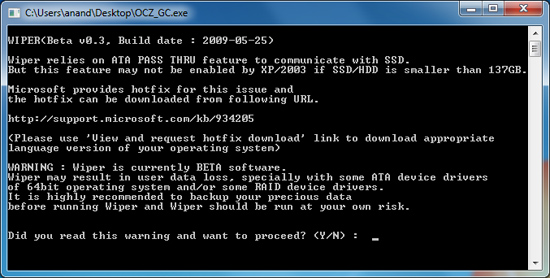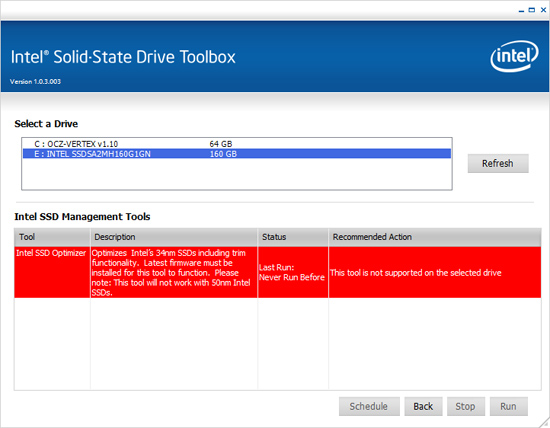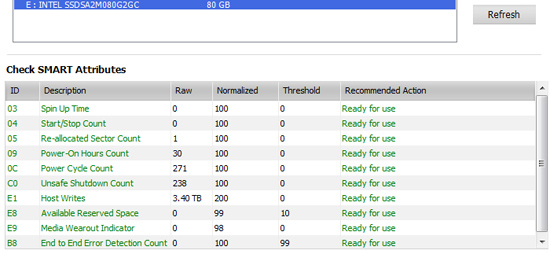The SSD Improv: Intel & Indilinx get TRIM, Kingston Brings Intel Down to $115
by Anand Lal Shimpi on November 17, 2009 7:00 PM EST- Posted in
- Storage
Wipe When You Can’t TRIM
There’s a major problem with TRIM today. The only Windows storage drivers to support it are written by Microsoft. The Intel Matrix Storage Manager (IMSM) driver will not pass the TRIM instruction to your SSD. This means you can't use anything but the drivers that ship with Windows 7. To make matters worse, if you enable non-member RAID on an Intel motherboard the default Windows 7 driver is an older version of IMSM so TRIM won't work there either - even if you don't have a RAID array created. Your best bet is to install Windows 7 with your I/O controller in AHCI mode (for Intel chipsets) and don't install any storage drivers. Intel is working on an updated IMSM that will pass the TRIM instruction to SSDs but it won't be ready for at least a couple of months.
TRIM won't work on a RAID array.
If you want to use IMSM or if you're using Windows XP or Vista, both of which do not support TRIM, there's another option. Earlier this year Indilinx released its Wiper Tool that performs a manual TRIM on their SSDs. It works by asking the OS for a list of the free space addresses on the partition and then sending the list with instructions to TRIM down to the SSD.

The Indilinx Wiper Tool
Today Intel introduces its own manual TRIM tool as a part of the SSD Toolbox:

On any Windows OS (XP, Vista or 7) regardless of what driver you have installed, Intel's SSD Toolbox will allow you to manually TRIM your drive. Intel calls it the SSD Optimizer, which of course only works on 34nm Intel SSDs (X25-M G1 owners are out of luck unfortunately).

The Intel SSD Optimizer lets you schedule the manual TRIM operation automatically
The SSD Toolbox also gives you access to SMART and drive health data, including telling you how many writes you've performed on your SSD, and what your current flash wear level is:

Running Intel's SSD Optimizer does work as advertised. I ran the PCMark HDD suite on a clean X25-M, once more on a drive that had been well used and once more after running the SSD Optimizer:
| PCMark Vantage HDD Score | Clean Run | Used Run | After SSD Optimizer |
| Intel X25-M G2 160GB | 35909 | 30354 | 34014 |
Intel's SSD Optimizer should be able to restore performance to about 95%+ of new, in this case it manages 94.7% - close enough.
Moving On: Forget About Invalid Data and Worry About Free Space
The existence of TRIM changes the way we test, something I alluded to in the SSD Relapse. Thankfully, we come prepared.
In previous articles we had to test SSDs in two conditions: new and used. The new state is just after a secure erase, the used state required us to write data to every user accessible portion of the drive first before benchmarking. The former resulted in great performance, the latter meant the SSD had to do a lot of juggling of existing data whenever it went to write. The second scenario no longer exists with TRIM. The act of formatting your drive or deleting files (and emptying the recycle bin) will TRIM invalid data.
Performance in a TRIM enabled system is now determined not by the number of invalid blocks on your SSD, but rather the amount of free space you have. I went into a deep explanation of the relationship between free space and the performance of some SSDs here.
TRIM will make sure that you don’t have to worry about your drive filling up with invalid data, but it doesn’t skirt the bigger issue: dynamic controllers see their performance improve with more free space.
My rule of thumb is to keep at least 20% free space on your drive, you can get by with less but performance tends to suffer. It doesn’t degrade by the same amount for all drives either. Some controllers are more opportunistic with free space (e.g. Intel), while others don’t seem to rely as much on free space for improved performance. Addressing performance degradation as drives fill up (with valid data) will be one of the next major advancements in SSD technology.










162 Comments
View All Comments
chizow - Wednesday, October 28, 2009 - link
Ya they had them for about 4 hours in an AM Shell Shocker for $240, which is their MSRP. They also had them for that price for about 8 hours at launch and since then its been gouged as high as $400 for a G2. All the other retailers that are selling for around the $240 MSRP are drop-shipping directly from Intel so they typically don't have stock in-hand and are estimating anywhere from 2-8 weeks for delivery....crimson117 - Monday, October 26, 2009 - link
Amazon has decent prices on these, but shipping time ranges from 2 weeks to 8 weeks.80GB G2 for $244: http://www.amazon.com/Intel-Mainstream-Solid-Retai...">http://www.amazon.com/Intel-Mainstream-...-Retail-...
160GB G2 for $467: http://www.amazon.com/Intel-160GB-Mainstream-Retai...">http://www.amazon.com/Intel-160GB-Mains...-Retail-...
Xentropy - Sunday, November 1, 2009 - link
5 days later now, and Amazon's up to $599 for the 160GB, though they are in stock instead of shipping in several weeks.Exar3342 - Tuesday, October 27, 2009 - link
I bought a G2 80GB yesturday via Amazon from a 3rd party company; was $244.00 (OEM) version. Good times.strikeback03 - Monday, October 26, 2009 - link
With your recommendation to keep at least 20% of a drive as free space, should it be within a partition, or just leave some unpartitioned space on the drive?Anand Lal Shimpi - Monday, October 26, 2009 - link
Either way works, just don't put data on it :)Take care,
Anand
Doormat - Monday, October 26, 2009 - link
Anand: great review.The 40GB 5-channel version has read speeds of 170MB/s. Does this mean that if the 10-channel G2 weren't inhibited by SATA 3Gb/s, it would probably get 340MB/s? Or is there diminishing returns on adding more channels.
Also, any price cuts on the horizon or just stagnating until drives start shipping with SATA 6Gb/s support.
Anand Lal Shimpi - Monday, October 26, 2009 - link
It's possible. All of the high end SSDs are bound by the interface for sequential read speed. I'm not sure how fast the controller could go if it weren't bound by the interface, but over 300MB/s sounds quite likely.Flash prices haven't really gone down lately from what I'm hearing. I don't know of any price cuts on the horizon unfortunately. Next year.
Take care,
Anand
semo - Monday, October 26, 2009 - link
i don't think you will see any price cuts since intel can't make enough G2s.I tend to agree with others regarding SATA 3. If intel is not rushing to enable SATA 3 on their ICH anytime soon, why would they be coming out with SATA 3 devices?
ekerazha - Monday, October 26, 2009 - link
Anand,it's strange to see your
"Is Intel still my overall recommendation? Of course. The random write performance is simply too good to give up and it's only in very specific cases that the 80MB/s sequential write speed hurts you."
of the last review, is now a
"The write speed improvement that the Intel firmware brings to 160GB drives is nice but ultimately highlights a bigger issue: Intel's write speed is unacceptable in today's market."